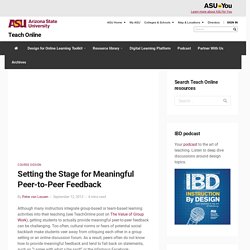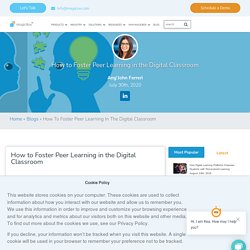

Youtube. Youtube. How to facilitate remote learning: Part 3 — Peer-to-peer interaction. In the wake of a health crisis — and to best keep students and educators safe — schools are re-evaluating their teaching practices and learning environments to accommodate an at-home, virtual learning experience.

The ability to make this fully functional and efficient falls squarely on IT. But, with the right tools in place, remote learning can be as simple and intuitive as in-person. In our five-part blog series, we identify five ways you can best serve students and teachers when you move learning online. We cover how to: Part 1: Set expectations for students and teachers Part 2: Facilitate engaging discussions daily. Peer learning. What is Peer Learning and Why is it Important?
Folks: The posting below looks at a still underutilized resource, students learning from other students.

It is from Chapter 1, Introduction: Making the move to peer learning, in Peer Learning in Higher Education: Learning From & With Each Other, edited by David Boud, Ruth Cohen & Jane Sampson. Published by Kogan Page Limited 120 Pentonville Road, London N1 9JN, UK and Stylus Publishing Inc. 22883 Quicksilver Drive Sterling, VA 20166-2012, USA. Copyright ? The power of peer learning and capacity building improving access to quality early care and education in philadelphia. Tech Buddies: Building Technology Skills Through Peer Teaching. Students as Teachers. Two of my recently graduated high school seniors, now college freshman, arrive at my classroom at 7:15 a.m. every Friday morning.

As I unlock my door, they ask, “So what are we teaching today?” The two former students are incredible — they stay all day, acting as teachers and mentors in my U.S. and World History classes. Many college freshmen might prefer to sleep in on days they don’t have classes. Not these two. During a lesson exploring two speeches by President Woodrow Wilson, they circulate, helping students define words, asking others to push their thinking further, answering questions while I’m working with another student. My two Friday helpers are not my only teacher apprentices. Peers as Role Models In a growing number of settings, educators are capitalizing on the positive impact of students teaching students. The opportunity to teach your peers sends a powerful message. The opportunity to teach your peers sends a powerful message.
Creating Opportunities in Your Classroom. Peer-to-Peer Learning. Encourage peer-to-peer learning to: Build an active and cooperative learning environment.

Encourage students to give and receive feedback and evaluate each others' learning. Promote positive interdependence and accountability. Setting the Stage for Meaningful Peer-to-Peer Feedback - Teach Online. Although many instructors integrate group-based or team-based learning activities into their teaching (see TeachOnline post on The Value of Group Work), getting students to actually provide meaningful peer-to-peer feedback can be challenging.

Too often, cultural norms or fears of potential social backlash make students veer away from critiquing each other in a group setting or an online discussion forum. As a result, peers often do not know how to provide meaningful feedback and tend to fall back on statements, such as “I agree with what s/he said!” Or the infamous Facebook-popularized, “I like it!” Protocols Establish Expectations and Guidelines One method for instructors to help their students communicate better and foster a friendly yet productive exchange is through the introduction of protocols. The idea of using protocols is not new and can be found in many educational settings for various purposes. RISE Model for Meaningful Feedback (Emiliy Wray, 2013) References Related. Using Online Groupwork to Improve Math Instruction. How to Set Up Online Group Work in High School Math. As math teachers, we find that our students learn best when they can collaborate.

In our book, The Math Teacher’s Toolbox, we note that cooperative learning—in which students learn by working together in small groups to complete a task—has several benefits: Students can construct a deeper understanding of the material, improve their self-confidence, reduce their math anxiety, and practice social and emotional learning skills. In addition, successful cooperative learning holds students individually accountable while making their success also dependent on others. The pandemic initially restricted our ability to implement traditional group work. Remote learning has burdened both students and teachers with overwhelming workloads, and in addition, our students spend most of the school day alone, passively watching lessons or silently working on assignments by themselves. Over the last few months, we’ve developed a simple cooperative learning strategy for our online teaching. Peer Learning Map. Steal This: Empowering Students Through Peer-to-Peer Learning.
How Access Students works is simple: Students choose a skill they have mastered, such as identifying perpendicular lines or dividing fractions, and come up with a short lesson.

The students then review the lesson with Yaw and get his approval on the lesson plan before recording it and uploading it to Access Students’ online platform. Access Students operates via VideoRehearser, a virtual training platform that can be used on any mobile device or computer. VideoRehearser is a low-to-no cost option for teachers: Educators can do a 30-day free trial followed by a $9 per month fee to use VideoRehearser, or they can request access to VideoRehearser for free in exchange for their feedback and testimonials.
Once a teacher is registered on VideoRehearser, all that’s needed to begin building a library of student-led lessons is a laptop, tablet, or phone with video recording capabilities. “You don't need anything extraordinary and nowadays, every kid has a cellphone,” Yaw says. Youtube. Cognitive Research Principles Peer Learning. How to Foster Peer Learning in the Digital Classroom - MagicBox™ Blog. How to Foster Peer Learning in the Digital Classroom If there’s one facet of modern learning methods that don’t get the attention it deserves, it probably is peer-to-peer learning.

It was used by Socrates, championed by the psychologist Lev Vygotsky and has been an integral part of the Montessori classroom. And now, Bridget Terry Long, dean of Harvard Graduate School of Education, opines that the current COVID-19 crisis is a time to encourage peer-to-peer learning. The model also helps form a strong foundation for future jobs, prioritizing collaboration, and communication skills, above all other soft skills.
Modern educators are increasingly capitalizing on the vast potential of students teaching each other. Traditional Peer Learning Methods Within the Classroom One of the most common ways to introduce peer learning within the classroom is to give students the reins of the class, if only for brief periods.